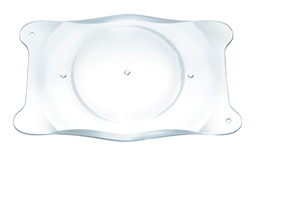EVO Implantable Contact Lens
(EVO ICL)
At LASIK Experts in Philadelphia, we know how important your eyesight is and how frustrating it can be to live with less than perfect vision. That is why we're dedicated to helping patients find vision solutions that improve their lives.

The good news is Dr. Shah at LASIK Experts has an option that will help you achieve exceptional quality vision!
It's called the Implantable Contact Lens (ICL).
Over 1 million procedures have been done worldwide and copious safety and efficacy data has been published about this in medical journals.

EVO ICL is a great option for patients with very high or complicated prescriptions.
Treating high prescriptions with LASIK isn’t always advisable, especially when better (and safer) options are available, like ICL.
At LASIK Experts, we’re dedicated to providing our patients with the best vision correction options possible. We don’t believe in the “one size fits all” mentality of some other providers. This is why we specialize in EVO ICL, a ground-breaking technology that corporate chains such as LASIK Plus and Laser Vision Institute can’t and don’t offer.
We believe every patient’s eyes are unique.
EVO ICL is able to correct common vision problems like myopia (nearsightedness), with or without astigmatism. Unlike other vision correction options, it doesn’t require the removal of corneal tissue. The lens used for the procedure is similar to a small contact lens. But instead of sitting on the surface of the eye, its placed inside. Once in place, the lens can’t be felt or seen by the naked eye.
EVO ICL requires no maintenance other than a routine, annual visit to your eye doctor. If for any reason your vision changes and/or you develop a cataract later in life, the implantable contact lens can be removed, giving you flexibility in the future.
The first step in the ICL process is a consultation with a member of the LASIK Experts team to discuss your eye health, vision goals, and map your personalized treatment plan.

Benefits of Implantable Contact Lenses
The EVO ICL has been in development for over two decades, and its benefits have been well established. The satisfaction rate amongst patients is extremely high – above 99%.
The benefits of the EVO ICL include:
- Quick results
- Offers UV protection
- Doesn’t cause dry eyes
- 99% patient satisfaction1
- Undetectable once in place
- Can be removed, if needed
- Can treat myopia, astigmatism
- Provides excellent night vision2
- Significant vision improvement3
- The procedure is virtually painless
- The procedure is quick (20 to 30 minutes)
- Over 1 million procedures performed worldwide4
- Can be an option for patients who aren’t good candidates for other vision correction treatments (such as LASIK and PRK)5
Am I a good candidate for EVO ICL?
General requirements for good candidates are those who:
- Are over the age of 21
- Have mild, moderate, or severe nearsightedness (myopia) with or without astigmatism
- Have no evidence of a cataract
- Have normal eye exams

Results and Recovery with EVO ICL
Sharper, clearer vision is possible with EVO ICL.
One of the benefits of EVO ICL is the quick procedure and recovery time. The procedure itself takes approximately 20 to 30 minutes, and most patients see a significant improvement in their vision immediately afterwards. The procedure is virtually painless, and we will offer you numbing drops for your comfort.
After the procedure, you’ll need a friend or family member to drive you home. You’ll be advised to rest for the remainder of the day, but most patients are able to return to work within 1 to 2 days of the procedure. We’ll schedule you for a follow-up appointment the day after your procedure.
Discuss with the Dr. Shah at LASIK Experts to see which procedure best suits your eyes.
We offer all refractive surgical options like LASIK, PRK, SMILE, implantable lenses and refractive lens exchange making us the most comprehensive and unique medical facility in the Greater Philadelphia area.
Ready to learn more about EVO ICL?
Important Safety Information
The EVO Visian ICL lens is intended to correct/reduce nearsightedness between -3.0 D up to -20.0 D and treat astigmatism from 1.0 D to 4.0 D. If you have nearsightedness within these ranges, EVO Visian ICL surgery may improve your distance vision without eyeglasses or contact lenses. Because the EVO Visian ICL corrects for distance vision, it does not eliminate the need for reading glasses, you may require them at some point, even if you have never worn them before. Since implantation of the EVO Visian ICL is a surgical procedure, before considering EVO Visian ICL surgery you should have a complete eye examination and talk with your eye care professional about EVO Visian ICL surgery, especially the potential benefits, risks, and complications. You should discuss the time needed for healing after surgery. Complications, although rare, may include need for additional surgical procedures, inflammation, loss of cells from the back surface of the cornea, increase in eye pressure, and cataracts. You should NOT have EVO Visian ICL surgery if your doctor determines that 1) the shape of your eye is not appropriate, 2) you do not meet the minimum endothelial cell density for your age at the time of implantation, 3) you have moderate to severe glaucoma, 4) your vision is not stable; or 5) if you are pregnant or nursing.
For additional information with potential benefits, risks and complications please visit DiscoverICL.com
1 MICL PMA data
2 Parkhurst G. A Prospective Comparison of Phakic Collamer Lenses and Wavefront-Optimized Laser-Assisted in Situ Keratomileusis for Correction of Myopia. Clinical Ophthalmology 2013; 10: 1209-1215.
3 Shin, JY. Ahn, H. Seo, KY. Kim, EK. Kim, TK. Comparison of higher order aberrations after implantable collamer lens implantation and wavefront-guide LASEK in high myopia. J Refract Surg. 2012; 28(2): 106 -111
4 Data on file. STAAR Surgical.
5 Parkhurst, G. Psolka, M. Kezirian, G. Phakic intraocular lens implantation in United States military warfighters: A retrospective analysis of early clinical outcomes of the Visian ICL. J Refract Surg. 2011;27(7):473 - 481